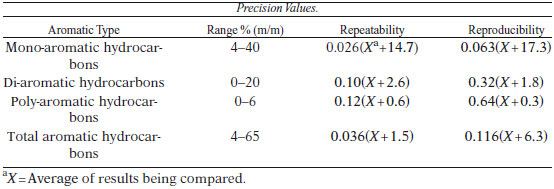Equivalent Test Methods: IP 391
EXPLANATION
The aromatic hydrocarbon content of motor diesel fuel is a factor that can affect exhaust emissions and fuel combustion characteristics, as measured by cetane number. Both U.S. EPA and California Air Resources Board limits the aromatic hydrocarbon content of diesel fuels. This test method is applicable to materials in the same boiling range as motor diesel fuels and is unaffected by fuel coloration.
This test method is intended to be used as one of several possible alternative instrumental test methods meant for quantitative determination of hydrocarbon types in fuels. It does not, however, imply that a correlation necessarily exists between this and any other test method intended to give this information.
This test method covers a high performance liquid chromatographic (HPLC) test method for the determination of monoaromatic, di-aromatic, and poly-aromatic hydrocarbon contents in diesel fuels and petroleum distillates boiling in the range from 150 to 400° C. The total aromatic content in % m/m is calculated from the sum of the individual aromatic hydrocarbon types. Aviation fuels and petroleum distillates with a boiling point range from 50 to 300° C are not determined by this test method and should be analyzed by Test Method D6379, or other suitable test methods.
This test method is calibrated for distillates containing from 4 to 40 % m/m mono-aromatic hydrocarbons, 0 to 20 % m/m di-aromatic hydrocarbons, 0 to 6 % m/m polycylic aromatic hydrocarbons, and 4 to 65 % m/m total aromatic hydrocarbons. Compounds containing sulfur, nitrogen, and oxygen are possible interferents. Mono-alkenes do not interfere, but conjugated di- and poly-alkenes, if present, are possible interferents.
TEST SUMMARY
A known mass of the sample is diluted in the mobile phase, and a fixed volume of this solution is injected into an HPLC instrument fitted with a polar column. This column has little affinity for the nonaromatic hydrocarbons while exhibiting a pronounced selectivity for aromatic hydrocarbons. As a result of this selectivity, the aromatic hydrocarbons are separated from the nonaromatic hydrocarbons into distinct bands in accordance with their ring structure, that is, MAHs, DAHs, and PAHs. At a predetermined time after the elution of DAHs, the column is back-flushed to elute the PAHs as a single sharp band. The column is connected to a refractive index (RI) detector that detects the components as they elute from the column. The electronic signal from the detector is continually monitored by a data processor. The amplitudes of the signals (peak areas) from the sample aromatics are compared with those obtained from previously run calibration standards in order to calculate % (m/m) of MAHs, DAHs, and PAHs in the sample. The sum of these is reported as total aromatic content (% m/m) of the sample.
TEST PRECISION
No information can be presented on the bias of this procedure because no material having an accepted reference value is available.




